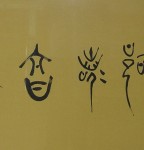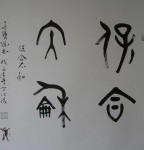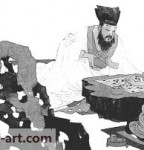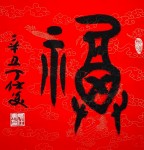Romantic Charm (Verve) in Chinese Calligraphy,
Bang Script Banner,
Calligrapher: Ding Shimei
Artwork size: 180cm×90cm
Creation year: 2010AD
On the Calligraphic Aesthetics of the Tang Dynasty:
The Tang Dynasty is a historical stage when the art of calligraphy reaches its general maturity and high prosperity. It was during this period that the glorious attainments and the special verve of the art of Chinese calligraphy were broadly and concentratively manifested. It was during this significant period that the spirit of Chinese art and the spirit of aesthetics attained the summit in development.
During the Tang Dynasty, all calligraphic forms, including inscription on steles, models, inscription on hardware utensils, inscription on stone tablets and epigraph, had been fully developed. Furthermore, it was a time of great masters such as Ou, Yu, Zhu, Xue, Li and Sun, Zhang, Yan, Huai, Liu. The calligraphic creation outgrew the pursuit for verve and began to advocate rules.
As rules grow out of verve and the later is assimilated into rules while the form is harmonized with the spirit, the art of Chinese calligraphy reached a majestic aesthetical acme.Meanwhile, the calligraphic theory and aesthetics also obtained great achievements. Volumes of epoch-making magnum opuses represented by SHU PU came forth, shaping the intensive and magnificent calligraphic aethetics rich of philosophic ideas. Embodied in kai shu, it is expressed by the pursuit for masculine beauty, in cao shu by romantic natural beauty.
It advocates the ontological idea that calligraphy links to the law of nature. The law of calligraphy represents the communication between man and nature. Therefore, the ideation of calligraphic creation, the using of calligraphic skills, the structure of the calligraphic work and the art of composition all have to base on the law of nature and the existence and movement of the universe. It exposed the nature of the art of calligraphy, of which calligraphic works is materialized form of the author"s emotional experience and its expression.
It set up new criterion and principle for calligraphic appreciation and critics. In general, the calligraphic aethetics of the Tang Dynasty is the accurate embodiment of the unity of the state, the flourish of all ethnic groups, the prosperity of politics, economy and culture. Diachronically, it is the development of the calligraphic aethetics of the Wei Jin period; synchronically, it is influenced by the philosophy of Confucianism, Taoism and Buddhism popular at that time, social ethnics and other cultural and artistic ideas and fully manifested the all-around prosperity of the Tang Dynasty.
| < Prev | Next > |
|---|
- 2010-10-09 - Ding Shimei Cursive Script Banner, "A bosom friend afar brings a distant land near. "
- 2010-10-01 - Ding Shimei, official script, "Smooth water runs deep"
- 2010-09-20 - 丁仕美榜书书法横幅《无为》
- 2010-09-09 - 丁仕美大篆书法横幅《大道无形》
- 2010-08-23 - Romantic Charm (Verve), Ding Shimei Bang Script Tower
- 2010-08-07 - Small Regular Script, Zhong Shaojing, Lin Fei Jin, Buddhist Sutra, 43 line ink version
- 2010-08-05 - Lin Jiang Xian - Cursive Script Banner
- 2010-08-04 - Bronze Ding vessel with Mao Gong Inscription
- 2010-08-02 - Shi Qiang bronze pan vessel. Middle Western Zhou period, Seal Script
- 2010-07-30 - 北宋米芾《苕溪诗卷》高清欣赏














